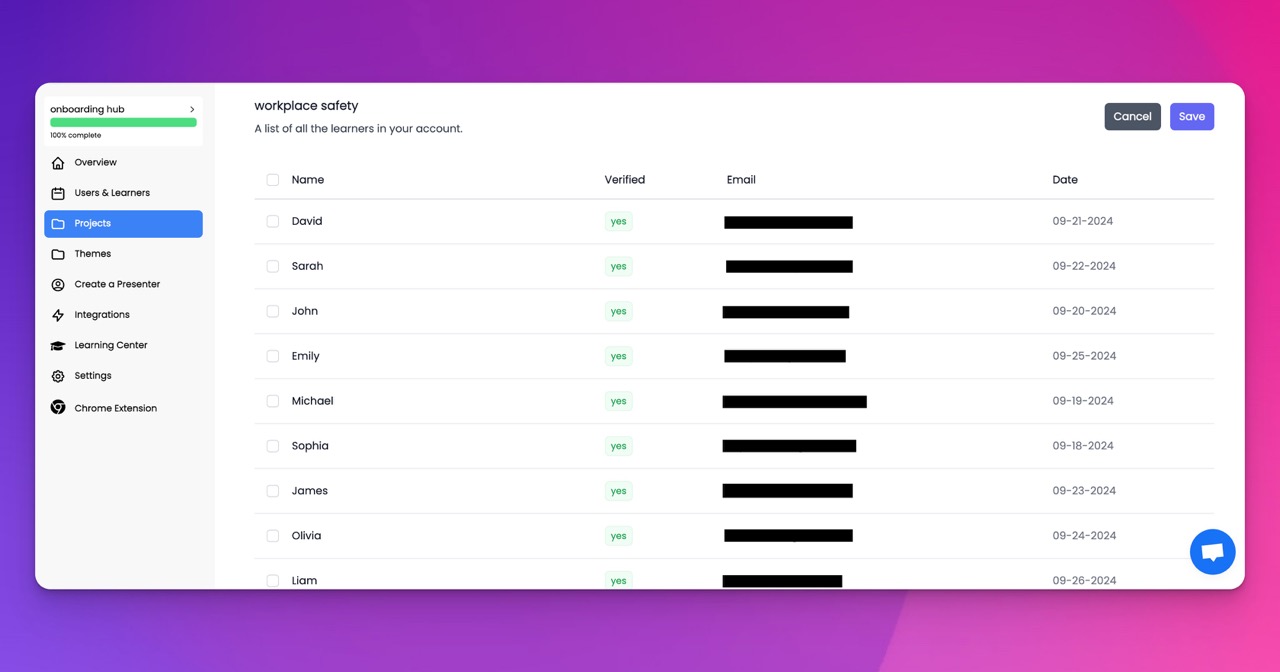🎉 Trainday now integrates with Zendesk and Hubspot 🎉 Trainday now integrates with Zendesk and Hubspot 🎉 Trainday now integrates with Zendesk and Hubspot
🎉 Trainday now integrates with Zendesk and Hubspot
🎉 Trainday now integrates with Zendesk and Hubspot
Contact
Safety in Small Steps - The Power of Microlearning for Effective Safety Training
Workplace safety is a non-negotiable priority, yet traditional safety training often falls short of its goal. Long presentations and dense manuals can overwhelm employees, making it hard to retain critical information and apply it effectively. Enter microlearning: a revolutionary training approach that delivers safety education in short, focused bursts, ensuring better understanding, retention, and application.
Let’s explore how microlearning is reshaping safety training by breaking down complex protocols into manageable steps, empowering employees to stay safe every day.
The Microlearning Approach to Safety Training
Microlearning delivers training content in small, digestible lessons, focusing on one key concept or skill at a time. Typically lasting 3 to 10 minutes, these modules use videos, infographics, quizzes, and interactive elements to engage learners.
For safety training, this format is ideal. Instead of cramming every protocol into a lengthy session, microlearning introduces safety concepts gradually, reinforcing them over time. This "small steps" approach helps employees absorb critical information without feeling overwhelmed.
Why Microlearning Works for Safety Training
1. Better Knowledge Retention
Safety training is often information-heavy, covering a wide range of protocols, hazards, and compliance requirements. Traditional methods risk cognitive overload, causing employees to forget key details. Microlearning combats this by breaking down safety topics into focused modules, making it easier for employees to process and remember.
For example, instead of delivering a single, hour-long presentation on fire safety, microlearning can offer a series of short lessons: identifying fire hazards, using extinguishers, and understanding evacuation routes.
2. Immediate Application
Microlearning emphasizes actionable knowledge that employees can apply immediately. This is especially valuable for safety training, where the ability to recall and act on information quickly can prevent accidents.
Imagine an employee encountering a hazardous spill. A quick refresher on spill containment and cleanup procedures, accessed via a mobile device, could guide them to resolve the issue safely and efficiently.
3. Engagement Through Interactivity
Traditional safety training can feel dry and repetitive, leading to disengagement. Microlearning leverages interactive elements like quizzes, scenarios, and gamification to keep employees engaged and invested in their learning.
For instance, an interactive module on machine safety might include a simulation where employees identify potential risks in a virtual workspace, making the lesson both memorable and practical.
4. Flexibility for Busy Schedules
Safety training often pulls employees away from their work, which can be disruptive to productivity. Microlearning allows employees to complete lessons during downtime, on their own schedules. With mobile-friendly content, they can access training anywhere, whether it’s during a break or while commuting.
This flexibility ensures that safety education doesn’t disrupt operations while still equipping employees with essential knowledge.
5. Adaptability to Role-Specific Needs
Different roles have different safety requirements. Microlearning enables organizations to tailor training content to specific job functions, ensuring relevance and effectiveness.
For example:
A construction worker might complete modules on ladder safety and equipment handling.
A healthcare professional might focus on infection control and patient handling.
An office employee might review fire evacuation procedures and ergonomic best practices.
This targeted approach ensures employees receive training that’s directly applicable to their work environments.
6. Continuous Reinforcement
Safety isn’t a one-time lesson—it’s a continuous priority. Microlearning supports ongoing education by reinforcing key concepts over time. Regular refresher modules ensure that employees stay sharp on safety protocols, reducing the likelihood of complacency.
Spaced repetition, where critical topics are revisited periodically, helps embed safety practices into daily routines.
Microlearning in Action: Real-World Safety Training Applications
Hazard Identification: Short lessons teach employees how to recognize potential risks in their work environments.
Emergency Procedures: Quick modules provide step-by-step instructions for evacuations, medical emergencies, or equipment malfunctions.
Compliance Training: Focused lessons ensure employees understand and adhere to OSHA or industry-specific safety regulations.
Personal Protective Equipment (PPE): Interactive tutorials demonstrate proper usage and maintenance of safety gear.
How to Implement Microlearning for Safety Training
Identify Key Safety Priorities Break down your safety protocols into specific, actionable topics. Each topic can become its own microlearning module.
Leverage Technology Use platforms like Trainday to create and distribute safety training modules. These tools make it easy to design engaging content and track employee progress.
Incorporate Real-World Scenarios Use examples and case studies that reflect your employees’ work environments to make lessons more relatable and impactful.
Make It Mobile-Friendly Ensure employees can access training on their smartphones or tablets, enabling learning on the go.
Monitor and Optimize Collect feedback and track analytics to identify gaps in understanding and refine your training program.
The Long-Term Benefits of Microlearning for Safety Training
Reduced Incidents and Accidents
Better knowledge retention and immediate application lead to safer workplaces, reducing the likelihood of injuries and costly disruptions.
Improved Compliance
Focused, up-to-date training ensures employees adhere to safety regulations, avoiding fines or legal complications.
Stronger Safety Culture
Microlearning fosters a culture of continuous improvement, where safety becomes a shared responsibility across the organization.
Accelerate Compliance.
Deliver OSHA-Ready Courses Instantly.
Empower your team with data-driven training solutions tailored to your industry's safety standards. Stay compliant, reduce risks, and boost productivity with AI-powered course creation.
